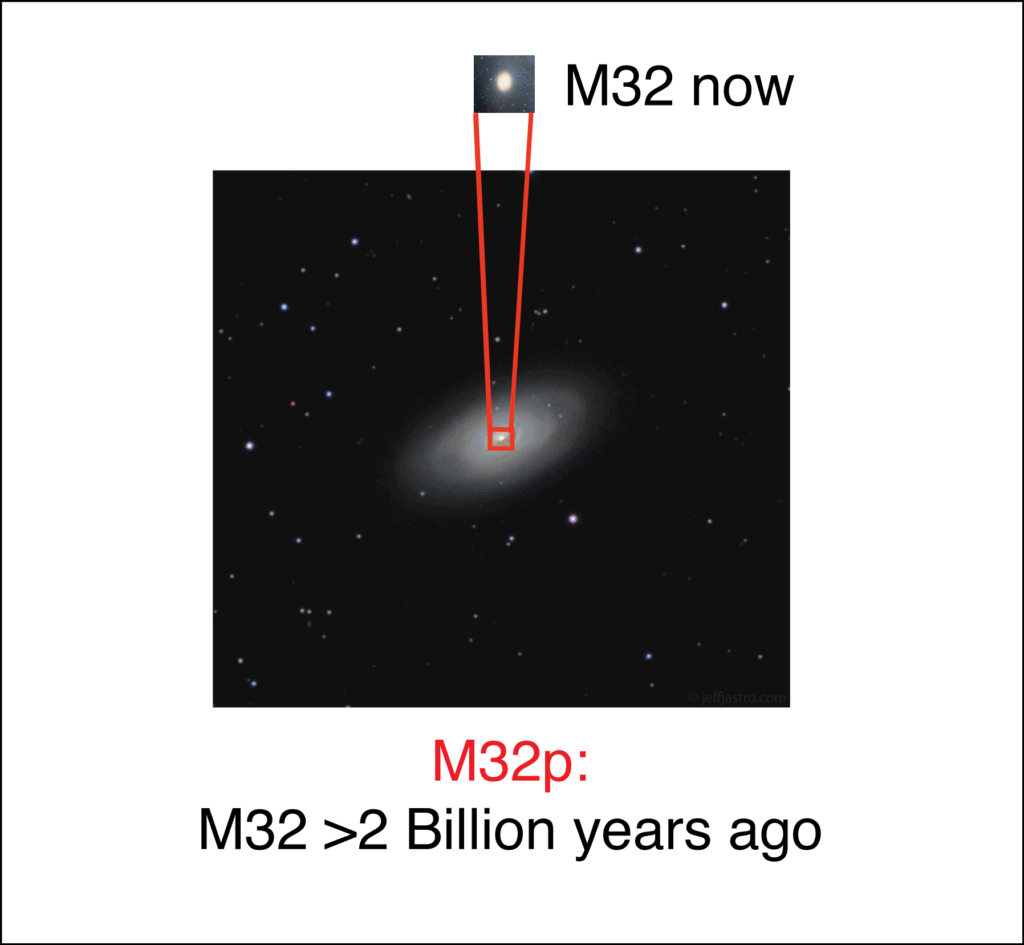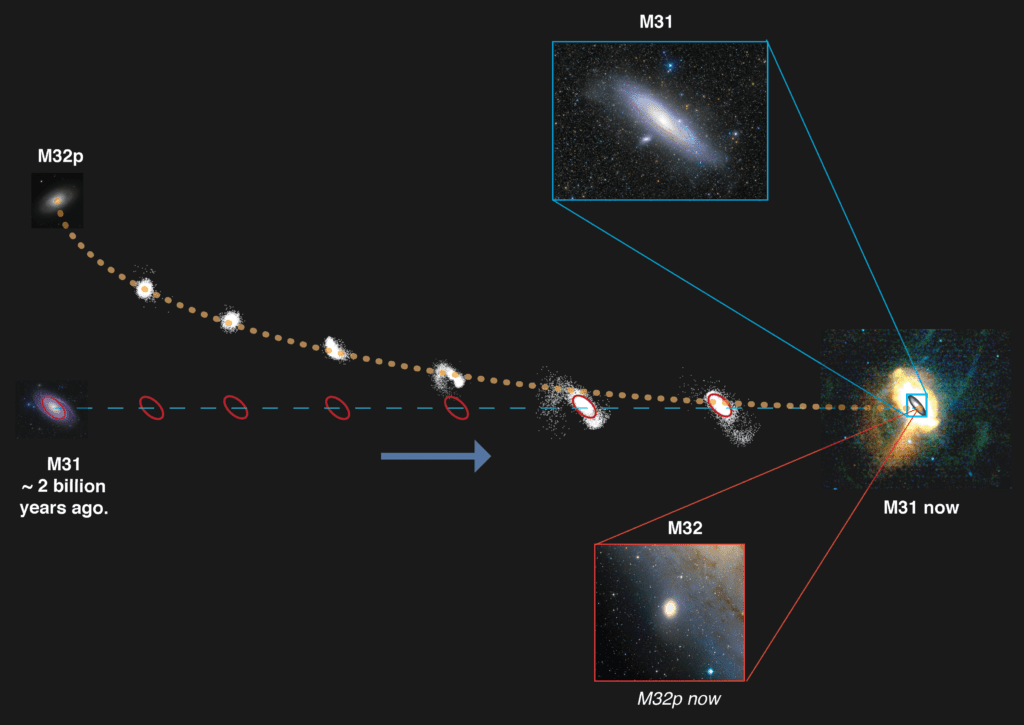Our closest galactic neighbor, Andromeda, seems to like the taste of its brethren.

Image credits Adam Evans.
Researchers from the University of Michigan (UoM) report that the Andromeda galaxy smote and consumed one of its brethren some two billion years ago. Although its victim was shredded almost completely, the team pieced together evidence of the collision from the thin halo of stars that spans the gap between Andromeda and its enigmatic companion, Meiser 32 (M32).
The discovery helps further our understanding of how galaxies like the Milky Way evolve, and of their behavior during large mergers.
Family dinner
Our own galaxy, the Milky Way, and our closest neighbor, Andromeda, are the two largest members of a group known as the Local Group (of galaxies). The extended family includes some 54 different galaxies — most of them dwarf galaxies acting as satellites for their larger relatives — all orbiting around a point roughly between Andromeda and the Milky Way.
It may sound idyllic, but researchers have found that at least one member of this group found its demise at the hands of Andromeda. This once-galaxy, christened M32p, was the third-largest member of the Local Group — a distinction that now falls on the galaxy Triangulum.
The team started their research using data pertaining to the halo of stars around Andromeda. It’s not a unique feature; many galaxies harbor such wispy-thin groupings of stars around their bulk, the final remnants of smaller galaxies that they absorbed over time. Since Andromeda is so large and rich in matter (it has over double the diameter of the Milky Way and double its number of stars), the researchers expected it to have consumed hundreds of smaller galaxies — which they thought would make it impossible to study a single such meal.

Image credits Richard D’Souza; for the image of M64: NOAO/AURA/NSF.
However, the team’s computer simulations revealed that although Andromeda did dine on many of its companion galaxies, most stars in the outer halo originate from a single, large galaxy. Piecing the evidence together to peer back in time, the team found that M32p would have been massive — likely the third-largest in the Local Group, after Andromeda and the Milky Way. The paper adds that M32p was at least 20 times larger than any galaxy the Milky Way ever merged with.
“The stars in Andromeda are very metal-rich and considerably young,” Richard D’Souza, lead author of the paper, explained in an e-mail. “In general, the larger the galaxy the more metal rich the stars are. We suspected that since the stars in the halo of Andromeda were so metal-rich, it must have come from a large metal-rich galaxy.”
One big bite
A metal-rich halo large enough to encompass a galaxy such as Andromeda could only be formed “through a single large merger,” he adds, noting that “there are not many smaller galaxies in the Universe to build up to the mass of the halo”.
“In terms of a business analogy, galaxies also grow through mergers and acquisitions. In order for a major company to grow at a very fast pace, it would need to acquire a similar large company into its business. Such was the case with Andromeda,” D’Souza adds.
The findings call into question our models of how mergers between two massive galaxies play out. Until now, astronomers believed that such an event would flatten the disk of a spiral galaxy into an elliptical one, but Andromeda’s disk evidently pulled through still very spiral-shaped. Some effects of this collision can still be seen, D’Souza told me. Among them are the thickness of Andromeda’s disk and the higher speeds its stars travel at (90 km/s compared to around 30 km/s in the Milky Way).

Image credits Richard D’Souza; M31, courtesy of Wei-Hao Wang; Stellar halo of M31: AAS/IOP.
Still, he admits that it came as “a major surprise” that Andromeda could retain its spiral shape following this collision. One explanation could be that the particular angle of the collision between the two galaxies helped keep Andromeda spiral-like, “but we need to run more computer simulations to see which set of orbits helps preserve the disk”.
Beyond this, it helps us better understand Andromeda’s evolution over time. The timing of the merger coincides with a burst of intense star formation in Andromeda two billion years ago. All this star-forming activity also suggests that M32p must have been gas-rich in order to supply enough building blocks.
Finally, the findings point to Andromeda’s mysterious, compact, and very dense, satellite galaxy M32 (the one today) as the last sliver of the once-mighty galaxy — the naked core. This piece of data could help explain why we see so few galaxies similar to M32 zipping around in the universe.
“M32 is a weirdo,” co-author Eric Bell, UoM professor of astronomy, said in a press release. “While it looks like a compact example of an old, elliptical galaxy, it actually has lots of young stars. It’s one of the most compact galaxies in the universe. There isn’t another galaxy like it.”
“Galaxies like M32 are considerably rare in the Universe,” D’Souza adds. “The term used for them in the literature is called ‘compact ellipticals’, and they are one of the most rarest galaxies in the Universe. We do know a dozen or so compact ellipticals in the nearby Universe, and we have inferred that further out (where we cannot resolve them), the number is equally low.”
As part of the paper, the team also found that the merger scenario could help explain the scarcity of M32-like objects. It seems the secret is not just in the merging process itself, but also in the particular makeup of the galaxies involved. “What one really needs is a galaxy with a high central surface density of stars comparable to M32,” D’Souza explains. It seems to be quite a rare occurrence — the team only identified 8 potential progenitors for M32-like objects.
Their study may alter the traditional understanding of how galaxies evolve, the researchers say. The realization that Andromeda’s disk survived an impact with a massive galaxy flies in the face of our current models, which suggests that such large interactions would destroy disks and form an elliptical galaxy.
It went so fundamentally against the grain of our understanding of galaxy-formation that, previously, we didn’t even consider the possibility that this scenario could have ever occurred.
“Astronomers have been studying the Local Group–the Milky Way, Andromeda and their companions–for so long. It was shocking to realize that the Milky Way had a large sibling, and we never knew about it,” Bell concludes.
Such investigative methods can be applied to other galaxies as well, the team explains, to help us tease out the merger history of other galaxies besides Andromeda.
The paper “The Andromeda galaxy’s most important merger about 2 billion years ago as M32’s likely progenitor” has been published in the journal Nature Astronomy.






